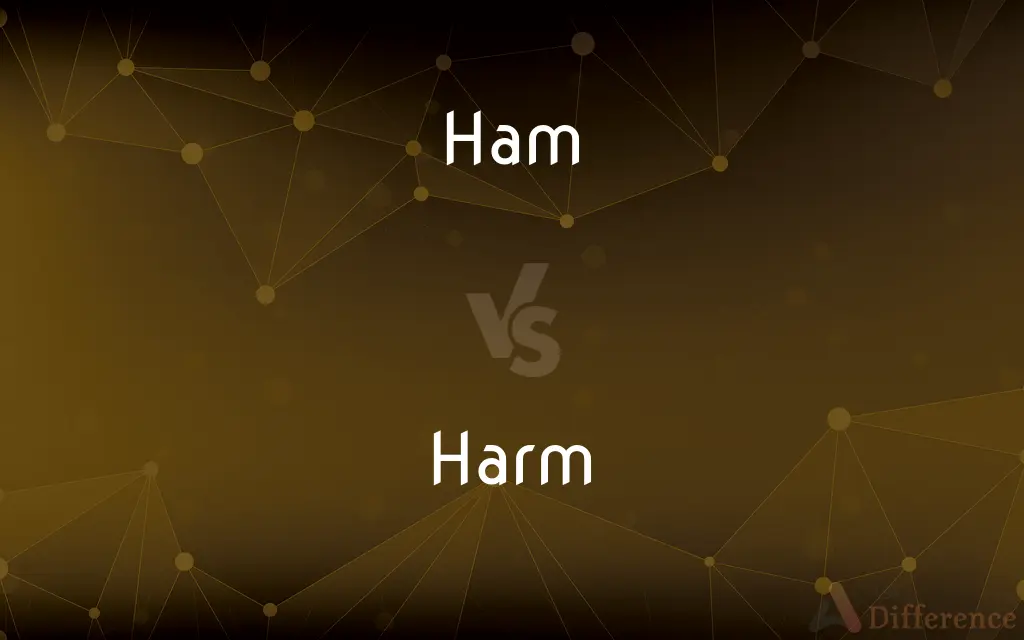Ham vs. Harm — What's the Difference?
By Fiza Rafique & Urooj Arif — Updated on March 30, 2024
Ham is a cured pork product, whereas harm refers to damage or injury.

Difference Between Ham and Harm
Table of Contents
ADVERTISEMENT
Key Differences
Ham is a type of meat that comes from the hind leg of a pig and is preserved through curing, smoking, or salting. It's a popular food item, especially in Western cuisines, enjoyed in various dishes from breakfast to dinner. On the other hand, harm is a concept that involves physical injury, psychological damage, or detrimental effects on something or someone. It's a broad term that can apply to people, animals, objects, and environments.
While ham is often associated with festive occasions and cultural traditions, such as Easter hams and Christmas feasts, harm is universally regarded as something to avoid. It has negative connotations and is often the subject of laws, regulations, and personal precautions aimed at preventing injury or damage.
Ham production involves a series of processes that can include curing with salt, sugar, and various seasonings, followed by smoking or aging. This not only preserves the meat but also imparts distinctive flavors. Harm, in contrast, can be caused by a wide range of factors, including accidents, deliberate actions, natural disasters, and diseases, impacting health, well-being, and property.
The enjoyment of ham can be influenced by personal taste preferences, dietary restrictions, and cultural practices. Some people choose not to eat ham for health reasons, ethical considerations, or religious beliefs. Conversely, harm is universally undesirable, and efforts to prevent or mitigate it are common across cultures and societies.
In culinary contexts, ham can be a versatile ingredient, featured in sandwiches, salads, and main dishes. It adds flavor and richness to recipes. Harm, however, has no positive role or desired presence in any context; it is something that individuals and societies strive to minimize or eliminate.
ADVERTISEMENT
Comparison Chart
Definition
Cured pork product from a pig's hind leg.
Damage or injury to someone or something.
Context
Culinary, often associated with traditions.
Universal, related to physical, psychological, or environmental damage.
Production/ Cause
Curing, smoking, or salting processes.
Caused by accidents, actions, natural disasters, or diseases.
Perception
Enjoyed and celebrated in various cultures.
Universally avoided and negative.
Usage
In culinary dishes for flavor and sustenance.
Subject of prevention and mitigation efforts.
Compare with Definitions
Ham
A type of cured pork that comes from the hind leg of a pig.
For the holiday dinner, they prepared a glazed ham.
Harm
Psychological damage that affects someone's emotional state or well-being.
Bullying can lead to serious emotional harm.
Ham
A pre-sliced ham that is cut in a continuous spiral around the bone for easy serving.
She bought a spiral-cut ham for easy serving at the party.
Harm
Injury or damage to the body of a person or animal.
The accident caused physical harm to the passengers.
Ham
An Italian style of dry-cured ham that is typically sliced thin and served uncooked.
They wrapped melon slices with prosciutto for a simple appetizer.
Harm
Damage caused to the natural environment, affecting ecosystems and wildlife.
Industrial pollution has caused significant environmental harm.
Ham
Ham that has been cured with honey, giving it a sweet flavor profile.
They preferred honey-cured ham for its sweet and savory taste.
Harm
Financial damage or loss, affecting individuals, businesses, or economies.
The fraudulent scheme caused considerable economic harm to investors.
Ham
A ham variety that is dry-cured, often smoked, and aged for a distinctive flavor.
The country ham was a key ingredient in the Southern-style brunch.
Harm
Damage or injury recognized and actionable under the law.
The plaintiff sought compensation for the legal harm suffered.
Ham
Ham is pork from a leg cut that has been preserved by wet or dry curing, with or without smoking. As a processed meat, the term "ham" includes both whole cuts of meat and ones that have been mechanically formed.
Harm
Harm is a moral and legal concept. Bernard Gert construes harm as any of the following: pain death disability loss of ability or freedom loss of pleasure.Joel Feinberg gives an account of harm as setbacks to interests.
Ham
(in the Bible) a son of Noah (Gen. 10:1), traditional ancestor of the Hamites.
Harm
Physical or psychological damage or injury
The storm did great harm to the crops.
Ham
Overact
She hammed it up for the cameras
Harm
Immoral or unjust effects
They made a mistake and meant no harm.
Ham
The thigh of the hind leg of certain animals, especially a hog.
Harm
To do harm to
Pollutants that harm the environment.
People who were harmed in the accident.
Ham
A cut of meat from the thigh of a hog, often cured by salting or smoking.
Harm
Physical injury; hurt; damage
No harm came to my possessions.
You can do a lot of harm to someone if you kick them in the balls. Especially if they get revenge and bring out a bazooka and blast your head off.
Ham
The back of the knee.
Harm
Emotional or figurative hurt
Although not physically injured in the car accident, she received some psychological harm.
Ham
The back of the thigh.
Harm
Detriment; misfortune.
I wish him no harm.
Ham
Hams The buttocks.
Harm
That which causes injury, damage, or loss.
Ham
A performer who overacts or exaggerates.
Harm
To cause injury to another; to hurt; to cause damage to something.
Ham
A licensed amateur radio operator.
Harm
Injury; hurt; damage; detriment; misfortune.
Ham
To exaggerate or overdo a dramatic role; overact.
Harm
That which causes injury, damage, or loss.
We, ignorant of ourselves,Beg often our own harms.
Ham
To exaggerate or overdo (a dramatic role, for example).
Harm
To hurt; to injure; to damage; to wrong.
Though yet he never harmed me.
No ground of enmity between us knownWhy he should mean me ill or seek to harm.
Ham
(anatomy) The region back of the knee joint; the popliteal space; the hock.
Harm
Any physical damage to the body caused by violence or accident or fracture etc.
Ham
(countable) A thigh and buttock of an animal slaughtered for meat.
Harm
The occurrence of a change for the worse
Ham
(uncountable) Meat from the thigh of a hog cured for food.
A little piece of ham for the cat
Harm
The act of damaging something or someone
Ham
The back of the thigh.
Harm
Cause or do harm to;
These pills won't harm your system
Ham
Electronic mail that is wanted; mail that is not spam or junk mail.
Ham
Obsolete form of home
Ham
(acting) An overacting or amateurish performer; an actor with an especially showy or exaggerated style.
Ham
(radio) An amateur radio operator.
Ham
(acting) To overact; to act with exaggerated emotions.
Ham
Home.
Ham
The region back of the knee joint; the popliteal space; the hock.
Ham
The thigh of any animal; especially, the thigh of a hog cured by salting and smoking.
A plentiful lack of wit, together with most weak hams.
Ham
A person who performs in a showy or exaggerated style; - used especially of actors. Also used attributively, as, a ham actor.
Ham
The licensed operator of an amateur radio station.
Ham
To act with exaggerated voice and gestures; to overact.
Ham
Meat cut from the thigh of a hog (usually smoked)
Ham
(Old Testament) son of Noah
Ham
A licensed amateur radio operator
Ham
An unskilled actor who overacts
Ham
Exaggerate one's acting
Common Curiosities
What is ham made of?
Ham is made from the hind leg of a pig, cured through processes like salting, smoking, or aging.
Can ham be eaten raw?
Some types of ham, like prosciutto, are safe to eat raw because of the curing process.
What distinguishes ham from other pork products?
Ham specifically refers to the cured hind leg of a pig, distinct in preparation and flavor.
Can cooking ham eliminate harmful bacteria?
Yes, cooking ham to the right temperature can eliminate harmful bacteria.
Can ham be part of a healthy diet?
Yes, in moderation, as part of a balanced diet, considering its sodium content.
What are common ways to prevent harm?
Common ways include following safety guidelines, using protective gear, and avoiding risky behaviors.
What legal actions can be taken for harm?
Victims can seek damages through lawsuits for compensation for the harm suffered.
Is harm always physical?
No, harm can also be emotional, environmental, economic, or legal.
How does environmental harm affect humans?
It can impact health, livelihoods, and the quality of natural resources we depend on.
Is all harm intentional?
No, harm can be accidental, such as injuries from unforeseen accidents.
What types of ham are there?
Types include spiral-cut, country, honey-cured, and prosciutto.
How is emotional harm addressed?
Through support, counseling, and sometimes legal action, depending on the context.
Why is harm considered universally negative?
Because it implies injury, loss, or damage that adversely affects beings or objects.
Can harm to the environment be reversed?
In some cases, through restoration projects and reducing pollutants.
What makes prosciutto different from other hams?
It's an Italian dry-cured ham, eaten raw and known for its delicate flavor.
Share Your Discovery

Previous Comparison
Mass vs. People
Next Comparison
Pocket vs. PlacketAuthor Spotlight
Written by
Fiza RafiqueFiza Rafique is a skilled content writer at AskDifference.com, where she meticulously refines and enhances written pieces. Drawing from her vast editorial expertise, Fiza ensures clarity, accuracy, and precision in every article. Passionate about language, she continually seeks to elevate the quality of content for readers worldwide.
Co-written by
Urooj ArifUrooj is a skilled content writer at Ask Difference, known for her exceptional ability to simplify complex topics into engaging and informative content. With a passion for research and a flair for clear, concise writing, she consistently delivers articles that resonate with our diverse audience.
















































